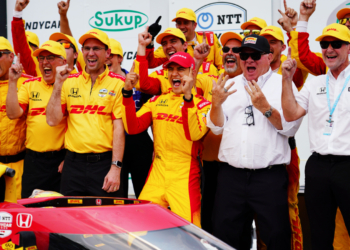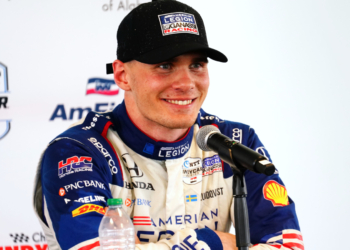As we are often called upon mournfully to note, Formula 1 and politics are inseparable. Yet whatever you think of F1’s political situation at any given moment of time, on one level you should always count yourself lucky. As it almost certainly will be an improvement on what it was in the period roughly between the mid-summer of 1980 and the early months of '81.
In the vast stretch of its history going all the way back to 1950, F1 cannot have come closer to stopping existing at all, at least in the form that we would recognise it, as it did in that period. Only – with appropriate absurdity – for it all to be resolved by a painted cow. Then a grand prix that wasn’t, which took place 38 years ago last week.
Yet for months before this even sober assessments had F1 not long for this earth. “Super imposed on it, the Sword of Damocles,” said Nigel Roebuck of 1980’s season-closing Watkins Glen round. “Had we seen the end of grand prix racing ‘as we know it’?”
All because of a battle between FISA – as the sporting arm of governing body the FIA was then known – and FOCA which were the constructors organised by a certain Bernard Charles Ecclestone.
And to understand how we got to that point, first a short history lesson. In the early 1970s the CSI, as FISA was then known, was powderpuff. Bernie, boss of the Brabham team, organised the constructors and moved in to fill the vacuum. FOCA organised the previously-ramshackle sport efficiently, started to do commercial deals with circuits and the like, and even influenced rules and circuit safety.
Super imposed on it [the final round of 1980], the Sword of Damocles. Had we seen the end of grand prix racing ‘as we know it’? – Nigel Roebuck
All dandy, until late 1978 when another notorious figure entered the stage. Jean-Marie Balestre – he of the “the best decision is my decision” fame – became FISA’s president and was determined to take the power back. The first battalions thus were poised for what became known as the ‘FISA-FOCA war’.
Come 1980 the two sides spent most of their time arguing about whether or not ‘skirts’ – a vital part of the time’s de rigueur underbody aerodynamics, but also associated with increasing cornering speeds and therefore safety concerns – should be banned for the 1981 season. FOCA pointed out that doing so was in contravention of the usual two years’ notice for such changes; FISA insisted that as a safety matter it could be done sooner.
But that’s not what it was really about. Heck, when FISA and FOCA fired the first shots of this war, at the 1980 Spanish Grand Prix in June that year, the point of departure was the trifling matter of whether drivers should pay fines for not attending a pre-race briefing…
No, it wasn’t really about any of this. It was about who ran the sport.
Another upshot of the Spanish stand-off was that the competing teams therein picked their sides. Loyal to FOCA loosely speaking were the Cosworth DFV powered British ‘garagistes’ such as Williams, Brabham and McLaren (and who also benefitted more from skirts). The ‘grandis’ manufacturers Ferrari, Renault and Alfa Romeo decided to stay loyal to FISA.
As everyone departed Watkins Glen for the 1980-’81 winter a way of achieving lasting peace was far from obvious. Neither side looked minded to back down. Threats, accusations, recriminations and brinkmanship were a constant din.
Bernie’s FOCA side in early November went so far as to announce its own breakaway sanctioning body, the World Federation of Motor Sport, and that it would run its own World Professional Drivers Championship. It abandoned these within a few weeks, switching strategies to instead seek to uphold its existing contracts with race organisers already signed for the 1981 F1 season.
We had no money, no sponsorship, no tyres and the whole Establishment against us – Max Mosley
There was then a legal to and fro which left FOCA apparently in a strong position. But FOCA had a problem. For all that we associate Bernie and his ally Max Mosley with grand strategy, in this case they were operating on a wing and a prayer. Money was drying up. About the only form of income for the FOCA teams was cash from sponsors and they, according to Mosley, were getting twitchy.
“Big international companies like Philip Morris (Marlboro) and Goodyear did not want to be associated with a ‘pirate’ championship or any sort of revolt against the established order,” Mosley noted. “Main boards were becoming involved and, however sympathetic those responsible for the racing budget might be, they warned that if it came to it, they would not be able to help us.”
As the 1980 calendar year drew to a close FOCA appeared to have nowhere to go. “We had no money, no sponsorship, no tyres and the whole Establishment against us,” recalled Mosley. Crawling back to Balestre and allowing him to dictate terms looked inevitable.
Which is where the painted cow came in. Mosley with Colin Chapman of Lotus and McLaren’s Teddy Mayer in mid-January attended the Hahnenkamm downhill ski race in Austria. In the dining room of their hotel there was a mural on the wall of two men painting directly onto a cow. Upon enquiry of what this bizarre sight was, the waitress told them that it was a scene from the Middle Ages wherein a nearby town under siege had run out of food and was close to surrender. But to give their enemy the impression that they had plenty they painted their one cow a different colour every day and took it to where their enemy could see it.
At this a light bulb pinged aglow above Chapman’s head, “we must put on a race even though we’ve got no money!,” he exclaimed. They phoned Bernie with the plan, who was initially sceptical – his first response was “you’re all pissed” – but he quickly saw the point and got on board.
The race, FOCA thought, could also possibly shake the resolve between the governing body and the grandis teams which was never that strong in the first place. Ferrari indeed had already sought to extend a hand across the divide by inviting the constructors to its base to frame a proposed settlement called the Modena Agreement.
We must put on a race even though we’ve got no money! – Colin Chapman
Furthermore FISA a few weeks before had explored the possibility of holding its own round one of the season, in Argentina, with Ferrari et al perhaps bringing three cars each, but the logistical problems were insurmountable. The significance would be lost on no one of FOCA succeeding in this most fundamental of racing tasks where FISA had failed.
The 1981 South African Grand Prix at Kyalami was scheduled originally for February 7, yet what with everything going on FISA sought to move it back to April, as it had with Argentina’s race. But this wasn’t acceptable to the South African organisers, mainly as the habitually financially-shaky event had secured race sponsorship with office equipment company Nashua, and its support was contractually contingent on the event being held on the February date.
At all this FOCA pounced and said it would race at Kyalami on February 7. In another happy coincidence for FOCA the South African race organisers didn’t care for Balestre, and were therefore receptive to playing ball. Tyres for the race came from Bernie, who just so happened to have a load of old productionised Goodyears in a warehouse spare from the British F1 series. The South African Grand Prix that wasn’t was on.
It was to some extent a damp squib, both figuratively and literally as rain fell on much of the Kyalami running. It was a decent enough race though with Carlos Reutemann’s Williams starting a wet race on slicks then leapfrogging to the front when the track dried and poleman and long-time leader Nelson Piquet in the Brabham had to pit for dry weather tyres. You could even have made the case – as Murray Walker did in his TV commentary – that the Piquet versus the Williams pair fight at the front was a seamless continuation from the end of the 1980 campaign.
Yet only 19 cars took part, even on Kyalami’s short 72-second lap there was close to a five second pace gap between those at the front and back, and the Hamlet without the Prince air was hard to ignore – no Ferrari; indeed no Renault which in 1980 had the Kyalami race to itself. “Even the most ardent enthusiasts had to admit that a race without Ferrari was like an international rugby championship without Wales,” noted Maurice Hamilton in the Guardian.
But in large part none of that mattered. What mattered is that the race happened at all; it was a serious race and, most crucially, got international TV coverage. The implication as calculated was clear: FOCA could put on a race; FISA, particularly given the Argentina false start, couldn’t.
The kaleidoscope was thus shaken, and the major subsequent breaking from FISA’s ranks came from Renault. Another thing that fell into FOCA’s lap was that the next scheduled race was in Long Beach. In California. In the USA. An important market for the French manufacturer, particularly as it owned American Motors. It was a race it couldn’t afford to sit out.
What mattered is that the race happened and, most crucially, got international TV coverage. The implication was clear: FOCA could put on a race; FISA couldn’t
Balestre then put Renault’s senior management noses out of joint by – in a typical fit of self-destructive foot in mouth – declaring arbitrarily that Renault would not race in the US. It soon became clear that, crucially as far as this story goes, the chastened Renault indeed fully intended to be in Long Beach with or without FISA’s blessing.
As for the rest of FISA’s ‘side’, Ferrari we’ve mentioned; the Commendatore Enzo Ferrari was showing time-honoured desire to be in whatever position was likely to give the Scuderia most advantage. Alfa wasn’t a major player and would fall into line. Overnight FISA’s power base had evaporated.
Crucially also FISA at no point appreciated the weakness of FOCA’s position. Mosley admits FOCA likely never would have been able to put on that Long Beach race alone, given its financial predicament. Indeed when FOCA officially announced that it would go ahead with its South African race – which is did in the Hotel Crillon in Paris right next to the FIA’s base – so much as a glance from Balestre at the bedraggled FOCA bunch would have told him much that he needed. Ensign boss Mo Nunn had mortgaged his house to access much-needed funds while Ken Tyrrell required Mosley to subsidise his air fare to Paris. Yet Balestre didn’t know any of this.
Instead he blinked first and gathered everyone around the table. The South African race would not count for the championship and skirts, of the sliding variety at least, were indeed banned. Though the garagistes proved adept in 1981 at finding ways around it.
Most pertinently we also got the Concorde Agreement – Balestre getting the compensation of sorts that it was named after the FIA’s Place de la Concorde address. It provided the basis on which F1 would be (and, under its successor incarnations, still is) run. It was (and is) shrouded in secrecy but its essentials were (and are) clear. FISA would look after the rules; Bernie (and, as it transpired, his successors) the deals. And, most likely, Bernie got the spoils too.






